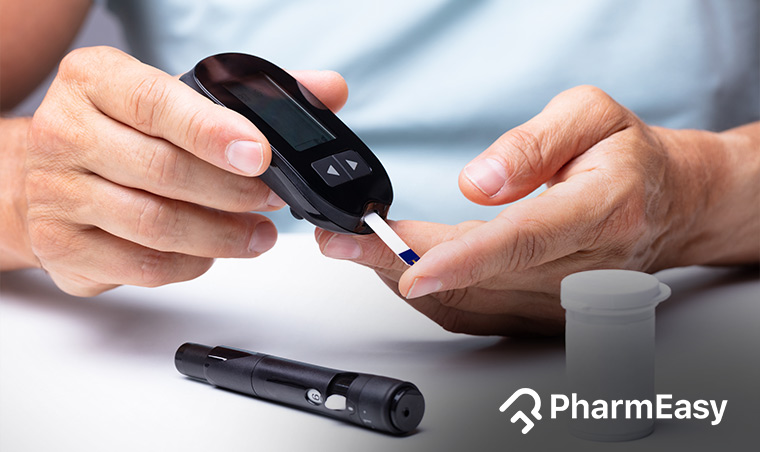Guide To Successful Self Blood Sugar Monitoring
By Dr. Nikita Toshi +2 more

Get,

to manage your symptom
Get your,


4 Cr+ families
benefitted

OTP sent to 9988776655



You’ve successfully subscribed to receive
doctor-approved tips on
Whatsapp

Get ready to feel your best.

Hi There,
Download the PharmEasy App now!!


Register to Avail the Offer
Send OTPBy continuing, you agree with our Privacy Policy and Terms and Conditions

Hi There,
Sign up on PharmEasy now!!
Trusted by 4 crore+ families

OTP sent to 9988776655



You have unlocked 25% off on medicines




Code: NU25
By Dr. Nikita Toshi +2 more
Table of Contents
Monitoring blood sugar levels is an essential management criterion if you are diagnosed with diabetes. Here, we are going to discuss when one needs to test their blood sugar, how often and the common mistakes to avoid.
A glucometer is a blood glucose meter that measures the sugar (glucose) level in your blood and displays it on a screen. It is a small and portable device capable of tracking the fluctuations and variations in your glucose level. Be it type I or type II diabetes, a glucometer helps measure your blood sugar at home.

Now that you know the importance of blood glucose meters, you need to know when to measure your sugar levels.
Many diabetic patients use sanitizer to clean before checking sugar. It is very important that the sanitizer is fully dried before pricking for blood or else they will get unusually high reading.
Dr. M.G. Kartheeka, MBBS, MD(Pediatrics)
This section will answer your when and how questions regarding blood glucose monitoring. A qualified physician, diabetes educator or more specifically,
a diabetologist’s consultation is necessary for designing your testing schedule. The information below is a general outline of recommendations by medical authorities.
To know whether your blood sugar is in range, laboratory tests must be opted. Your doctor will advise you in detail for the same.
The disadvantages with such instruments are mainly seen when either the patient lacks motivation to test or does not have sufficient education on how to interpret the results to make sufficient use of home testing equipment.
Dr. Ashish Bajaj ,M.B.B.S, M.D. in Clinical Pharmacology and Toxicology
The accuracy depends on the functioning of your glucometer and your ability to perform the procedure accurately. Let us learn step-by-step the correct way to test your blood glucose at home.
You should not use the instrument in cases of severe dehydration, low blood pressure, in cases of Shock, or to make a diagnosis of Diabetes, always seek an expert consultation before trying to measure the blood glucose in such situations.
Dr. Ashish Bajaj ,M.B.B.S, M.D. in Clinical Pharmacology and Toxicology
Disclaimer: The information provided here is for educational/awareness purposes only and is not intended to be a substitute for medical treatment by a healthcare professional and should not be relied upon to diagnose or treat any medical condition. The reader should consult a registered medical practitioner to determine the appropriateness of the information and before consuming any medication. PharmEasy does not provide any guarantee or warranty (express or implied) regarding the accuracy, adequacy, completeness, legality, reliability or usefulness of the information; and disclaims any liability arising thereof.
Links and product recommendations in the information provided here are advertisements of third-party products available on the website. PharmEasy does not make any representation on the accuracy or suitability of such products/services. Advertisements do not influence the editorial decisions or content. The information in this blog is subject to change without notice. The authors and administrators reserve the right to modify, add, or remove content without notification. It is your responsibility to review this disclaimer regularly for any changes.

Leave your comment...
Comments